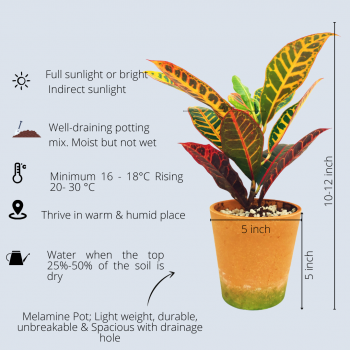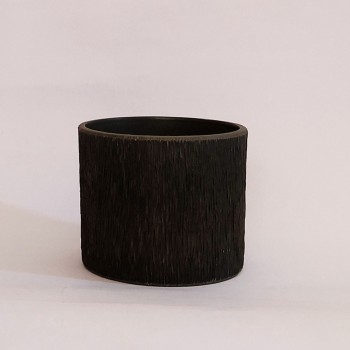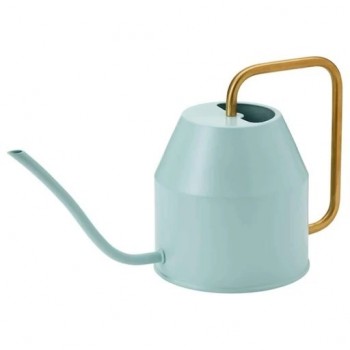The croton 'Petra' (Codiaeum variegatum 'Petra') is an evergreen shrub native to southern Asia. Crotons have some of the boldest and brightest foliage around. It prefers hot, humid weather and requires a good maintenance in order to thrive.
The stunning colors of Croton plants make them popular. Croton plants offer a colorful, non-flower option that can be planted outdoors (if the conditions are right) or indoors to brighten up a room. Foliage very rich in multiple color patterns that create a wonderful display.
This easy-care shrub features color and low-maintenance.
DIMENSION:
Height of the Product: 10-12 inch
Height of the the Planter: 5 inch
Material of the Planter: Melamine
Colour of the Planter: Brown
Package Contains : 1 Live Croton Plant + One 5" lightweight & durable Melamine Pot + A4 size Plant Care Tracker
Specific References
The Croton is one of the easiest plants to care for, making it a popular houseplant. It has variegated leaves with green, scarlet, orange, and yellow splotches.
Light
The plant should be placed under full sun or part sun.
Watering
It requires frequent watering, but not over watering.
Croton leaves are dust magnets. Gently wipe the leaves with a moist cloth twice a month to keep them clean and dust-free.
Soil
Use a well-draining potting mix. Croton like to be kept moist, but not wet. If the growing medium retains too much water, the plant may become subject to root rot.
Soil pH : Acidic 4.5 to 6.5
Temperature
Crotons prefer warm conditions (80 ℉ or below, or below). These are generally hardy to temperatures around 25 to 30 degrees Fahrenheit.
Humidity
Mist the leaves once a week with water if the humidity is low or keep a tray of wet gravel near the plant.
Fertilizer
Fertilize the plant in spring and summer, while the plant is actively growing. During the fall and winter months, fertilize less often or do not fertilize at all. The fertilizer should be high in Nitrogen and potassium.
Repotting
Repot the young croton every year in the spring or early summer for first three growing seasons.
Propagation
Propagate with a 3-4 inch stem cutting. The cutting should have 3-5 leaves on it and can be planted in a small pot to start. Keep the plant in a warm environment and maintain moisture in the soil. In these conditions, the plant will likely take root within a month and then you can transplant it elsewhere. As the croton plant matures, it will develop color.
Why is my croton plant losing its leaves?
Many reasons can cause crotons to lose leaves. In most cases, this plant loses its leaves due to some sort of stress. An imbalance of essential nutrients or moving the plant from outdoors to indoors are possible causes of this stress. Give the plant some time if it is just adjusting to a new environment. After a couple of weeks, it will settle in and begin to grow once again. If you haven’t moved your plant recently, leaf loss could be due to exposure to extreme temperatures, insufficient light, improper watering, or disease/pests.
Why are my Croton leaves drooping?
Due to dry soil or overwatering, low humidity, light issues, temperature stress, cold drafts, pests, and transplant shock Croton leaves get drooping.
Why did Crotons leaves fade?
Due to insufficient light or excessive direct light croton leaves fade.
Pests and Diseases
Crotons are generally free of most pests that attack houseplants; the one exception is mealybugs which can be resolved easily by physical removal or rubbing alcohol (isopropyl alcohol) or neem oil & soap mixture or any other standard houseplant insecticides.
When soil is kept too moist, fungus gnats can be another problem which can be treated by Hydrogen peroxide solution ( 1:4) or Lemon-dish soap solution (1:2).



























